This article was published as a part of the Data Science Blogathon.
Apple’s Siri and Google’s voice search both use Recurrent Neural Networks (RNNs), which are the state-of-the-art method for sequential data. It’s the first algorithm with an internal memory that remembers its input, making it perfect for problems involving sequential data in machine learning. It’s one of the algorithms responsible for the incredible advances in deep learning over the last few years. In this article, we’ll go over the fundamentals of recurrent neural networks, as well as the most pressing difficulties and how to address them.
Introduction on Recurrent Neural Networks
A Deep Learning approach for modelling sequential data is Recurrent Neural Networks (RNN). RNNs were the standard suggestion for working with sequential data before the advent of attention models. Specific parameters for each element of the sequence may be required by a deep feedforward model. It may also be unable to generalize to variable-length sequences.

Recurrent Neural Networks use the same weights for each element of the sequence, decreasing the number of parameters and allowing the model to generalize to sequences of varying lengths. RNNs generalize to structured data other than sequential data, such as geographical or graphical data, because of its design.
Recurrent neural networks, like many other deep learning techniques, are relatively old. They were first developed in the 1980s, but we didn’t appreciate their full potential until lately. The advent of long short-term memory (LSTM) in the 1990s, combined with an increase in computational power and the vast amounts of data that we now have to deal with, has really pushed RNNs to the forefront.
Table of contents
- Introduction on Recurrent Neural Networks
- What is a Recurrent Neural Network (RNN)?
- The Architecture of a Traditional RNN
- How does Recurrent Neural Networks work?
- Common Activation Functions
- Advantages and disadvantages of RNN
- Recurrent Neural Network Vs Feedforward Neural Network
- Backpropagation Through Time (BPTT)
- Two issues of Standard RNNs
- RNN Applications
- Basic Python Implementation (RNN with Keras)
- Frequently Asked Questions
- Conclusion
What is a Recurrent Neural Network (RNN)?
Neural networks imitate the function of the human brain in the fields of AI, machine learning, and deep learning, allowing computer programs to recognize patterns and solve common issues.
RNNs are a type of neural network that can be used to model sequence data. RNNs, which are formed from feedforward networks, are similar to human brains in their behaviour. Simply said, recurrent neural networks can anticipate sequential data in a way that other algorithms can’t.

All of the inputs and outputs in standard neural networks are independent of one another, however in some circumstances, such as when predicting the next word of a phrase, the prior words are necessary, and so the previous words must be remembered. As a result, RNN was created, which used a Hidden Layer to overcome the problem. The most important component of RNN is the Hidden state, which remembers specific information about a sequence.
RNNs have a Memory that stores all information about the calculations. It employs the same settings for each input since it produces the same outcome by performing the same task on all inputs or hidden layers.
The Architecture of a Traditional RNN
RNNs are a type of neural network that has hidden states and allows past outputs to be used as inputs. They usually go like this:


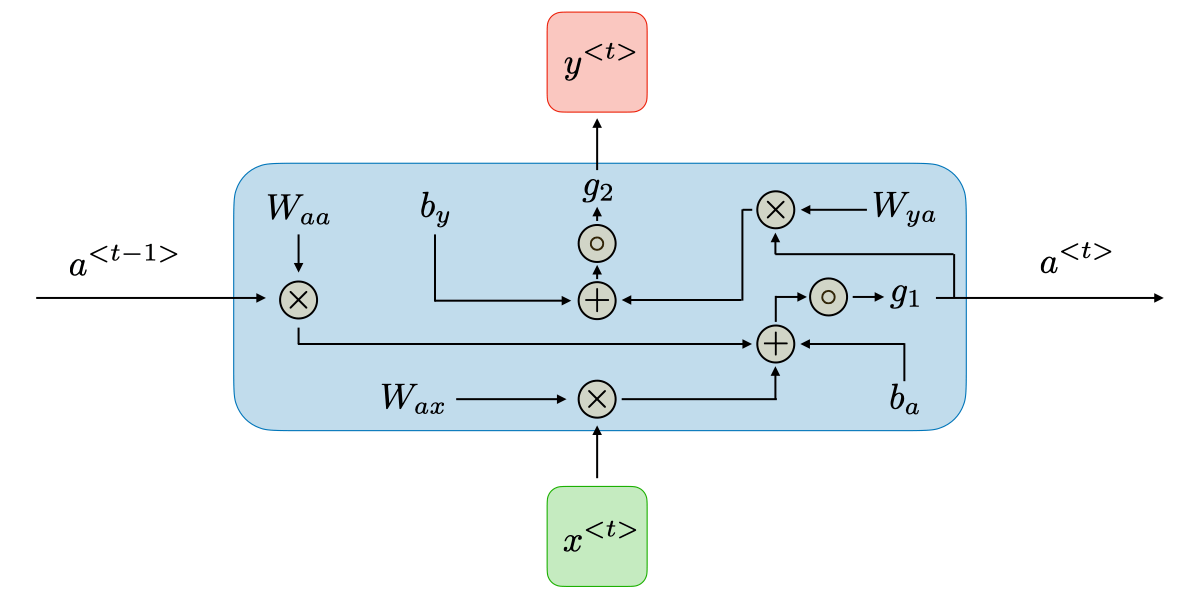
RNN architecture can vary depending on the problem you’re trying to solve. From those with a single input and output to those with many (with variations between).
Below are some examples of RNN architectures that can help you better understand this.
- One To One: There is only one pair here. A one-to-one architecture is used in traditional neural networks.
- One To Many: A single input in a one-to-many network might result in numerous outputs. One too many networks are used in the production of music, for example.
- Many To One: In this scenario, a single output is produced by combining many inputs from distinct time steps. Sentiment analysis and emotion identification use such networks, in which the class label is determined by a sequence of words.
- Many To Many: For many to many, there are numerous options. Two inputs yield three outputs. Machine translation systems, such as English to French or vice versa translation systems, use many to many networks.
How does Recurrent Neural Networks work?
The information in recurrent neural networks cycles through a loop to the middle hidden layer.
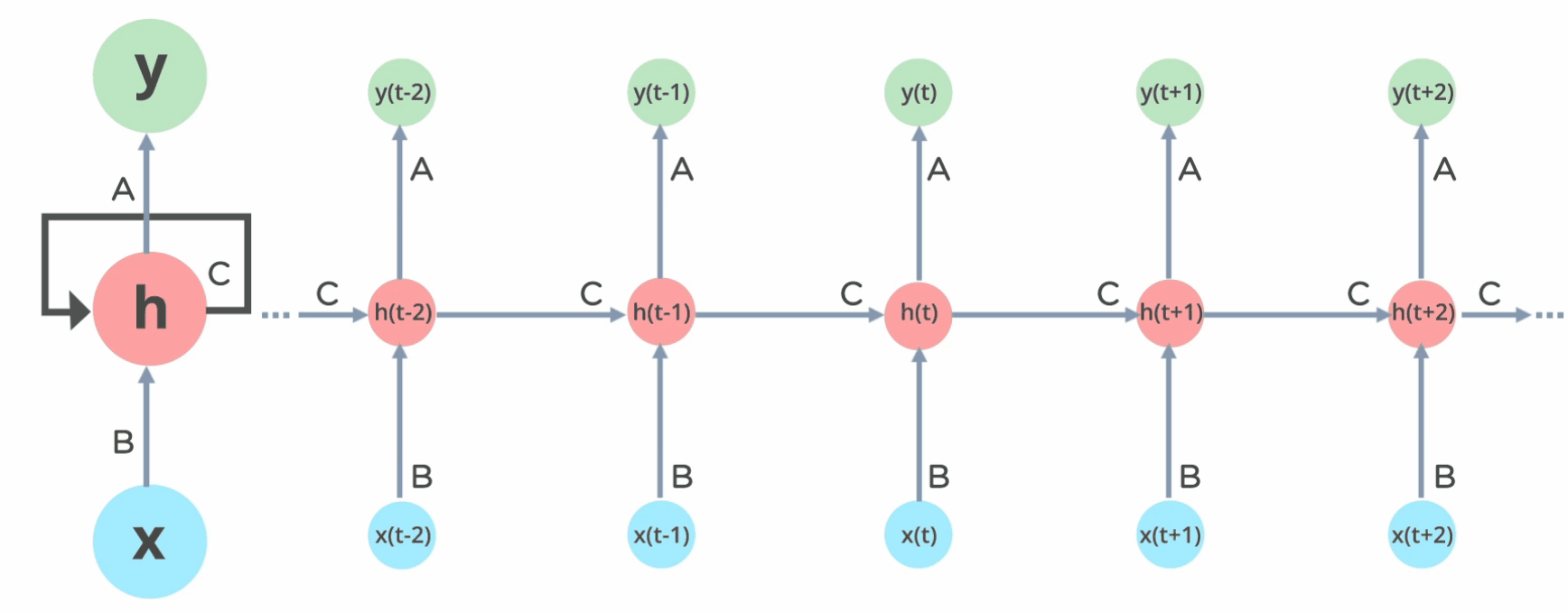
The input layer x receives and processes the neural network’s input before passing it on to the middle layer.
Multiple hidden layers can be found in the middle layer h, each with its own activation functions, weights, and biases. You can utilize a recurrent neural network if the various parameters of different hidden layers are not impacted by the preceding layer, i.e. There is no memory in the neural network.
The different activation functions, weights, and biases will be standardized by the Recurrent Neural Network, ensuring that each hidden layer has the same characteristics. Rather than constructing numerous hidden layers, it will create only one and loop over it as many times as necessary.
Common Activation Functions
A neuron’s activation function dictates whether it should be turned on or off. Nonlinear functions usually transform a neuron’s output to a number between 0 and 1 or -1 and 1.
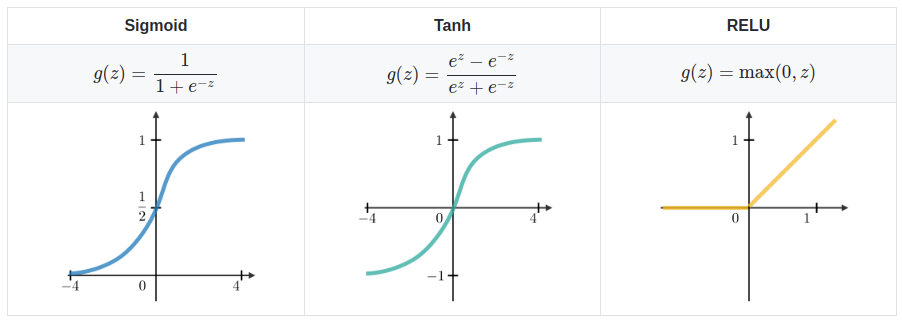
The following are some of the most commonly utilized functions:
- Sigmoid: The formula g(z) = 1/(1 + e^-z) is used to express this.
- Tanh: The formula g(z) = (e^-z – e^-z)/(e^-z + e^-z) is used to express this.
- Relu: The formula g(z) = max(0 , z) is used to express this.
Advantages and disadvantages of RNN
Advantages of RNNs:
- Handle sequential data effectively, including text, speech, and time series.
- Process inputs of any length, unlike feedforward neural networks.
- Share weights across time steps, enhancing training efficiency.
Disadvantages of RNNs:
- Prone to vanishing and exploding gradient problems, hindering learning.
- Training can be challenging, especially for long sequences.
- Computationally slower than other neural network architectures.
Recurrent Neural Network Vs Feedforward Neural Network
A feed-forward neural network has only one route of information flow: from the input layer to the output layer, passing through the hidden layers. The data flows across the network in a straight route, never going through the same node twice.
The information flow between an RNN and a feed-forward neural network is depicted in the two figures below.
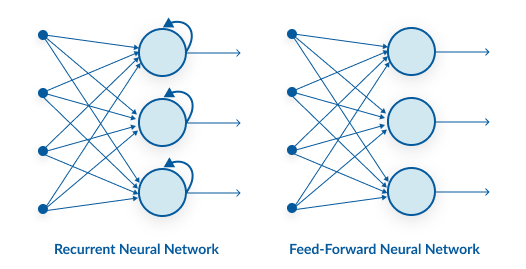
Feed-forward neural networks are poor predictions of what will happen next because they have no memory of the information they receive. Because it simply analyses the current input, a feed-forward network has no idea of temporal order. Apart from its training, it has no memory of what transpired in the past.
The information is in an RNN cycle via a loop. Before making a judgment, it evaluates the current input as well as what it has learned from past inputs. A recurrent neural network, on the other hand, may recall due to internal memory. It produces output, copies it, and then returns it to the network.
Backpropagation Through Time (BPTT)
When we apply a Backpropagation algorithm to a Recurrent Neural Network with time series data as its input, we call it backpropagation through time.
A single input is sent into the network at a time in a normal RNN, and a single output is obtained. Backpropagation, on the other hand, uses both the current and prior inputs as input. This is referred to as a timestep, and one timestep will consist of multiple time series data points entering the RNN at the same time.
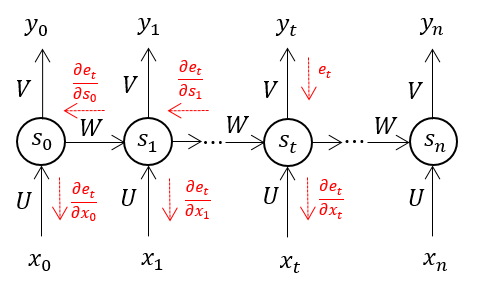
The output of the neural network is used to calculate and collect the errors once it has trained on a time set and given you an output. The network is then rolled back up, and weights are recalculated and adjusted to account for the faults.
Two issues of Standard RNNs
There are two key challenges that RNNs have had to overcome, but in order to comprehend them, one must first grasp what a gradient is.
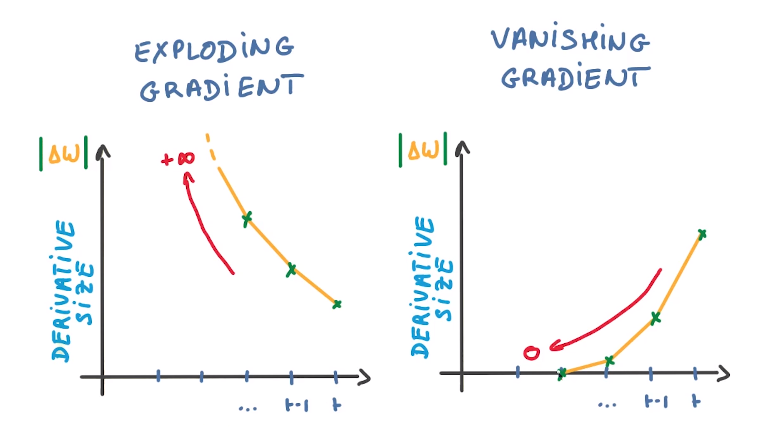
With regard to its inputs, a gradient is a partial derivative. If you’re not sure what that implies, consider this: a gradient quantifies how much the output of a function varies when the inputs are changed slightly.
A function’s slope is also known as its gradient. The steeper the slope, the faster a model can learn, the higher the gradient. The model, on the other hand, will stop learning if the slope is zero. A gradient is used to measure the change in all weights in relation to the change in error.
- Exploding Gradients: Exploding gradients occur when the algorithm gives the weights an absurdly high priority for no apparent reason. Fortunately, truncating or squashing the gradients is a simple solution to this problem.
- Vanishing Gradients: Vanishing gradients occur when the gradient values are too small, causing the model to stop learning or take far too long. This was a big issue in the 1990s, and it was far more difficult to address than the exploding gradients. Fortunately, Sepp Hochreiter and Juergen Schmidhuber’s LSTM concept solved the problem.
RNN Applications
Recurrent Neural Networks are used to tackle a variety of problems involving sequence data. There are many different types of sequence data, but the following are the most common: Audio, Text, Video, Biological sequences.
Using RNN models and sequence datasets, you may tackle a variety of problems, including :
- Speech recognition
- Generation of music
- Automated Translations
- Analysis of video action
- Sequence study of the genome and DNA
Basic Python Implementation (RNN with Keras)
Import the required libraries
import numpy as np
import tensorflow as tf
from tensorflow import keras
from tensorflow.keras import layersHere’s a simple Sequential model that processes integer sequences, embeds each integer into a 64-dimensional vector, and then uses an LSTM layer to handle the sequence of vectors.
model = keras.Sequential()
model.add(layers.Embedding(input_dim=1000, output_dim=64))
model.add(layers.LSTM(128))
model.add(layers.Dense(10))
model.summary()Output:
Model: "sequential"
_________________________________________________________________
Layer (type) Output Shape Param #
=================================================================
embedding (Embedding) (None, None, 64) 64000
_________________________________________________________________
lstm (LSTM) (None, 128) 98816
_________________________________________________________________
dense (Dense) (None, 10) 1290
=================================================================
Total params: 164,106
Trainable params: 164,106
Non-trainable params: 0
|
Frequently Asked Questions
A. Recurrent Neural Networks (RNNs) are a type of artificial neural network designed to process sequential data, such as time series or natural language. They have feedback connections that allow them to retain information from previous time steps, enabling them to capture temporal dependencies. This makes RNNs well-suited for tasks like language modeling, speech recognition, and sequential data analysis.
A. A recurrent neural network (RNN) works by processing sequential data step-by-step. It maintains a hidden state that acts as a memory, which is updated at each time step using the input data and the previous hidden state. The hidden state allows the network to capture information from past inputs, making it suitable for sequential tasks. RNNs use the same set of weights across all time steps, allowing them to share information throughout the sequence. However, traditional RNNs suffer from vanishing and exploding gradient problems, which can hinder their ability to capture long-term dependencies.
Conclusion
- Recurrent Neural Networks are a versatile tool that can be used in a variety of situations. They’re employed in a variety of methods for language modelling and text generators. They’re also employed in voice recognition.
- This type of neural network is used to create labels for images that aren’t tagged when paired with Convolutional Neural Networks. It’s incredible how well this combination works.
- However, there is one flaw with recurrent neural networks. They have trouble learning long-range dependencies, which means they don’t comprehend relationships between data that are separated by several steps.
- When anticipating words, for example, we may require more context than simply one prior word. This is known as the vanishing gradient problem, and it is solved using a special type of Recurrent Neural Network called Long-Short Term Memory Networks (LSTM), which is a larger topic that will be discussed in future articles.
Read more articles on our blog. Head onto it now!
The media shown in this article is not owned by Analytics Vidhya and are used at the Author’s discretion.




